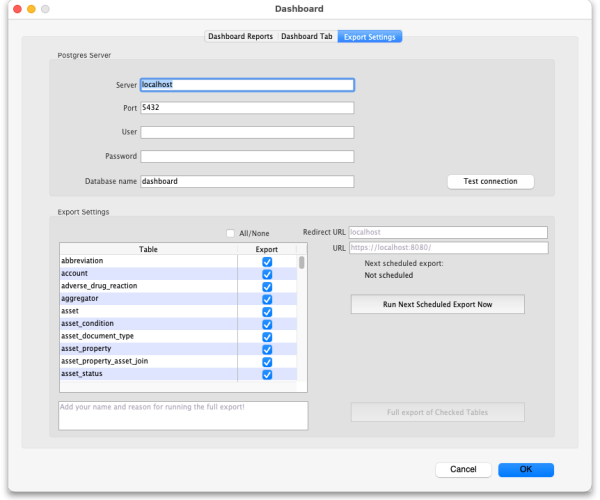17.24. Exporting to the dashboard
Function fixed: mSupply version 5.03.00
This information is for sending data from your mSupply database to the mSupply dashboard database. The dashboard has a separate Postgres database so that its use does not slow down or interfere with your use of mSupply.
To access Dashboard export settings (administrators only), click on the Admin tab of the Navigator and click on the Dashboard icon:
Click on the Export Settings tab and you will see this window:
Postgres server section
In here you enter the details of the dashboard database server:
- Server: the URL or IP address of the dashboard database server
- Port: the port on the server that the database is listening for connections
- User: The user name that mSupply will use to access the Postgres database
- Password: The password mSupply will use to access the Postgres database
- Database Name: The name of the database that mSupply is to access
To make sure the details are correct and your copy of mSupply has access to the dashboard database, click on the Test connection button. A message will tell you whether the connection is successful or not.
Once the dashboard is enabled and the correct Postgres settings entered, there will be an automatic (scheduled) export every 24 hours. The next scheduled export is shown in the Next scheduled export field. This export process can be edited to run at different intervals based on your needs.
Export settings section
This section enables you to manually export data to the dashboard apart from the scheduled dashboard export.
The time and date of the next scheduled export to the dashboard database are shown in the Next scheduled export field. By default, all table data is exported incrementally — that is, only records that are new or have been changed since the last export are exported, which saves a substantial amount of time in the export process.
Redirect URL field: contains the URL that you should be redirected to after login or logout of the dashboard. The URL must not contain the https:// part. When the dashboard is on the same server as the mSupply server this will be the same as the URL in the URL field, if they are on different servers then it will be different.
URL field: contains the URL of the dashboard, including the https:// and port e.g. https://localhost:8080.
The Run Next Scheduled Export Now button gives you a way of exporting the data immediately, without waiting for the next scheduled export. Useful if you want the dashboard to be updated immediately.
The Full export of Checked Tables button gives you a way of re-exporting the specific table data from scratch immediately. The table contains a list of all the database tables in mSupply that can be exported to the dashboard. Simply check the checkbox in the Export column to set that table to be exported to the dashboard when you click on The Full export of Checked Tables button. The All/None checkbox is a quick way of toggling between all tables selected and non-tables selected.
It is not advisable to run a full export of the database (i.e. including all database tables) unless really necessary. This is because it can take a loing time if the database is large and, during that time, some tables will be inaccessible so reports and other functions might not work in mSupply.
If you do run a full export (i.e. including all database tables) then you must enter your name and give a reason for the export in the Add your name and reason for running the full export! text field. This text will be added to the log.
When you click on either of them you must enter your authorisation code before the export will be carried out.
Click on the OK button to save your changes and the Cancel button to cancel any changes you have made.
| Previous: 17.23. Exporting assets | | Next: 18. Tenders |

